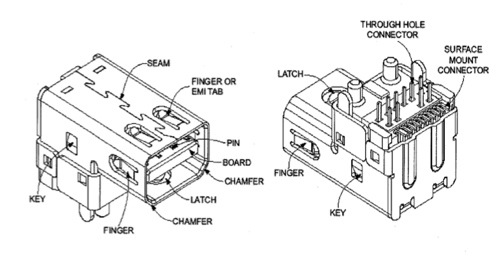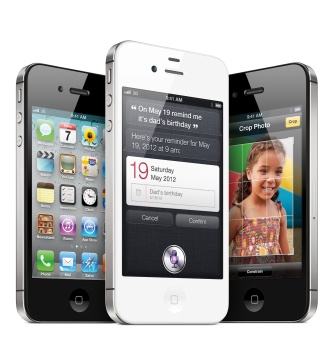Apple seems to be planning a new version of the Mini DisplayPort, according to a new patent (number 20110039443) at the US Patent & Trademark Office.
The patent involves connectors having a smaller profile. These connectors are useful as a reduced form factor DisplayPort connector. Keys on a receptacle are used to indicate when an insert is fully engaged. Edges of the receptacle and insert are chamfered in such a way as to prevent the pins of the connector from being damaged when an improper insertion is attempted. User experience is also enhanced by the use of one or more latches.
As the connector is inserted, the latch provides resistance that builds until the connector is inserted a certain distance, after which the latch enters a cutout portion of the insert thus releasing the pressure and letting the user know the connection has been made. Fingers are employed to provide mechanical stability and electrical connection between receptacle and insert. The inventors are Stewart Shannon Fields, Matthew K. Herndon, Min Chul Kim, Ron Larson, Richard J. Middlehurst, Anilkumar R. Pannikkat, Glenn Wheelock and Colin Whitby-Strevens.
Here’s Apple’s background and summary of the invention: “Many electronic devices connect to each other using cables typically made up of a number of wires connected to pins located in connectors at each end of the cable. These connectors then mate with connectors in the electronic devices. These connectors may be based on a standard, that is, the connector may have an agreed-to size and pin location, or they may be proprietary.
“Other connectors may be a hybrid of these, that is, the pin functions may be standardized, but the pin locations and connector form factor may be proprietary. Such a connector may be used on one end of a cable while a standard connector is used on the other. This arrangement has the advantage of allowing devices to use a proprietary connector to connect to a standardized device.
“In some applications it is desirable to reduce the size of these connectors. For example, a low height, or smaller z direction, allows a connector to be used on a thinner device. A narrower connector, a shorter x direction, allows more connectors to be included along an edge or side of a device.
“Unfortunately, smaller connectors require pin spacing to be reduced. Reduced spacing results in a higher level of signal crosstalk and interaction. This in turn diminishes signal integrity and hampers device performance.
“Smaller connectors may also create an undesirable user experience. That is, it may be hard for users to know when they have properly inserted the cable connector into the device connector. It may be hard for uses to know if they have inserted the connector in the correct direction and whether they have fully inserted the connector.
“Thus, what is needed are connectors having a reduced size, a high level of signal integrity, and provide a tactile feedback to users such that they can determine whether a connection has been properly made.
“Accordingly, embodiments of the present invention provide small form factor connector system for multi-lane high-speed digital interfaces. The profile, or form factor, of the connectors may be smaller in either or both height, or z direction, and width, or x direction. While these connectors are particularly useful as a smaller DisplayPort connector, referred to herein as a Mini DisplayPort connector, the concepts described herein may be used with other types of connectors. These connectors are useful as a reduced form factor DisplayPort connector, though embodiments may be used as connectors for other interfaces presently available, and it is expected that they will be useful for interfaces developed in the future.
“An exemplary embodiment of the present invention provides a connector receptacle that includes keys to indicate when a connector insert is fully engaged. Edges of the receptacle are chamfered such that a connector insert cannot be inserted upside down. This helps to prevent the pins of the connector and associated circuitry from being damaged when an improper insertion is attempted. User experience is also enhanced by the use of one or more latches. As the connector is inserted, the latch provides resistance that builds until the connector is inserted a certain distance, after which the latch enters a cutout portion of the insert thus releasing the pressure and letting the user know the connection has been made. Fingers are employed to provide mechanical stability and electrical connection between connector receptacle and connector insert.
“Another exemplary embodiment of the present invention provides connector insert to be inserted into a connector receptacle. The connector insert includes one or more cutout portions to receive the one or more latches on the connector receptacle when the connector insert is fully inserted into the connector receptacle. The frame of the connector insert has chamfered corners such that upside-down insertion into the connector receptacle is prevented.
“Embodiments of the present invention provide a connector design that allows peripheral devices to be connected to computers using high speed multi-lane digital signaling.”
— Dennis Sellers
dsellers@applecentral.com





